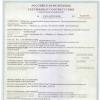Checking the zip signature. TWRP Recovery - instructions for use. Briefly about all TWRP Recovery menus
Those who use an Android tablet or smartphone on a daily basis often want to get more functionality than what is provided with the purchase. To do this, you need to get root rights (access to administrator rights), install custom firmware, install a different boot animation, and much more.
When a user studies information on changing their device, they often come across a mention of a modified recovery, which is usually referred to as ClockworkMod Recovery or TWRP Recovery. You can also find the general concept of modrecovery in other articles, but here we will take a closer look at another well-known type of modified factory menu, namely TWRP Recovery, which was developed by the Teamwin team.
Before we touch on the study of the functions of TWRP Recovery in more detail, it should be noted that in comparison with ClockworkMod there are a number of features due to which many users prefer to use TWRP:
- The ability to fully use the touch to control the functions of moderecovery;
- more flexible configuration of a number of options;
- support for installing several zip files at once;
- detailed menu choosing what to keep in backups;
- the ability to use S-Pen on Galaxy Note tablets;
- screen lock and sleep mode using the power button.
User manual for working with modrecovery TWRP Recovery
1. general information about TWRP
2. Installing TWRP Recovery
3. How to get into the TWRP Recovery menu
4. Detailed review of the main functions in the TWRP Recovery menu
5. Flashing, replacing system files, installing updates, modifications on Android devices using TWRP
What is TWRP Recovery
Let's get acquainted with what TWRP Recovery is.Compared to the standard factory menu, TWRP Recovery has a much larger number of user-accessible functions. With it, you can save a complete snapshot of the system, install non-standard software, other firmware, replace the OS kernel, restore the system from a backup, and many other features are available. TWRP is written to a special section of the internal memory of the phone or tablet, replacing the factory recovery.
Often, in a number of seemingly hopeless situations, TWRP Recovery can come to the rescue. Despite the fact that the phone may stop loading, it is not uncommon that using TWRP, you can completely restore the device from a backup copy, saving all settings, programs and their settings.
Here is a short list of the main features of TWRP Recovery:
- Installation of alternative (custom) firmware, or kernels;
- Installing system updates, fixes, making adjustments to the gadget's functions;
- Creating a full backup of the system or its individual parts (application data, system partition, cache, settings);
- Connecting via USB cable to a computer as a removable drive;
- Restoring the previous state of the system from a previously saved backup (backup);
- Editing partitions on the memory card (create, format, delete);
- Ability to reset to factory settings (Wipe - data / factory reset). You can delete only part of the data instead of completely resetting it to its original state: deleting battery statistics (wipe battery stats), clearing the cache (wipe cache), erasing dalvik-cache (wipe Dalvik-cache);
- Use as a terminal to execute commands;
- Ability to work with system files on a tablet or phone.
Installing TWRP Recovery
To install TWRP Recovery on most devices, a lot of effort is not required. If you install the GooManager application from Google Play, you can use the "Install OpenRecovery Script" function in its menu.Many Android gadgets, such as Nexus smartphones and tablets, have specially designed programs, like the Google Nexus 7 Toolkit, where there is a function to install a modified recovery. In addition, using the adb program, you can also install TWRP Recovery.
How to get into TWRP Recovery
In order to enter the menu of the modified recovery, you can use several methods:1. By pressing a special combination of buttons when turning on the gadget. The combination may vary for different Android device models. For example, on a number of devices, you can get into recovery by holding down the volume up keys and the power button while turning it on.
2. Using a specialized program, such as GooManager and Titanium Backup, which allow you to select the function of loading into Recovery mode in your menu, the "Reboot Recovery" item.
3. If the drivers corresponding to the gadget are installed on the PC and the connection is configured using the ADB program (the so-called ADB shell), then by connecting a cable from the computer to the USB device, you can run the command:
adb reboot recovery
Main functions and menus of TWRP Recovery
By booting your phone or tablet into TWRP Recovery, you will first be taken to the main menu.
This manual covers the features and capabilities of TWRP Recovery version 2.3.2, which is the most up-to-date at the time of this writing. Other versions of TWRP may have a slightly different interface, but the main functionality will remain the same as in the version we are considering.

The appearance of TWRP recovery may also differ slightly, depending on the specific device and the chosen theme.
Since TWRP recovery supports touch control, it is very easy to select the desired menu items and navigate through them - it is enough, just as in normal use of the gadget, to press the element we need with your finger.
If you want to return to the previous menu, then in each submenu there is a back button in the lower (phone) or upper right (tablet) part of the display. Also shown at the top is the battery percentage and the current time.
Functions of the main menu items:
1.Install

Used to install firmware, patches and modifications.
This is one of the most used features of TWRP Recovery.
Using this option, you can install custom (unofficial), official firmware, programs to the system partition, replace kernels, change bootanimation, themes, and more. Updates are installed from files located anywhere on the device's memory card, in zip format.
After selecting the desired file, a menu opens where you can add the next update. Thus, you can create a queue for installing patches (Add More Zips item). After the desired files are selected, you need to start the firmware by stretching the slider from the left side to the right, which is located at the bottom of the display.

The Zip Signature verifications feature can activate digital signature verification of zip files.
Using the Force MD5 check on all Zips item, the check of installed updates for compliance with MD5 checksums is activated.
2. Wipe Menu for clearing and deleting data

In this section, it is possible to clear the phone's memory, either by completely returning to the factory settings (Factory Reset), or by choosing to clear only a certain part of it, such as the System partition, cache (Cache), or Dalvik Cache. After applying the Factory Reset, the device will return to the state in which it came from the factory.
In addition, it is possible to clear the internal memory (Internal Storage) or external SD card (External Storage), clear the folder where the programs installed on the external media are stored (android_secure) or reset the battery statistics counter (Wipe Battery Stats).
Similar to other executable functions, you can confirm your choice using the slider that appears at the bottom of the display. You can cancel the execution of tasks by tapping on the "Back" button.
3. Backup Data or System Backup Partition

This is one of the most important points in the modified recovery. Here you can backup the entire system of your phone or tablet, including application data and device settings - Nandroid Backup.
In this section, you can:
- Select parts of the memory that you want to reserve: Data, System, Recovery, Boot, Uboot, Cache, NVram;
- Look at the available amount of memory space (Free Space);
- Disable creation of checksums in backup files (Skip MD5 generation during backup);
- Activate backup file compression (Enable Compression);
- Select the internal memory of the device to save backup data (Use internal storage);
- Select an external memory card to save backup files (Use external SD);
- Refresh information on free memory in sections (Refresh Sizes);
- Set a name for the backup (Set Backup name).
As before, you can activate the launch of the functions you have chosen using the slider, after which the progress of the operation will be shown.

When the process is completed, you can reboot the gadget using the Reboot System option, or return to the TWRP main menu using the arrow.
4.Restore Menu for restoring parts or the entire system from a previously created backup

This section provides the following options:
- selection of the internal memory of the device as a place where backup copies will be searched (Use internal storage);
- set an external memory card as a partition where the recovery will look for backup (Use external SD).
If you did not change the settings when creating a backup, then by default the names of the backups are made up of the number and time of creation. Files can be sorted in the following ways:
- ascending (Sort Ascending) or descending (Sort Descending) date of creation;
- increase or decrease the size of backups.

When the desired backup is found, the following selection of functions is provided:
- mark the partitions that need to be restored (Data, System, Recovery, Boot, Uboot, Cache, NVram);
- delete this backup (Delete Backup);
- give a different name to the selected backup (Rename Backup);
- enable checking MD5 checksums in backup files.
Start the selected operation by confirming the selection using the slider at the bottom of the screen.
5 Mount

Here you can mount and unmount partitions and perform operations on them. When mounted, the data contained on the partition becomes available.
This section contains features:
- Mounting, unmounting the system partition (Mount / Unmount System);
- Mounting, unmounting the cache partition (Mount / Unmount Cache);
- Mounting, unmounting the data partition (Mount / Unmount Data);
- Mounting, unmounting internal memory (Mount / Unmount Internal);
- Mounting, unmounting an external memory card (Mount / Unmount Sdcard);
- Connecting the device to a PC as a drive (Mount USB storage). Here you can connect an SD card (Use external SD) or the built-in memory of the gadget (Use internal storage) to the PC.
6.Settings Modified recovery settings

Here are the settings that TWRP Recovery will use by default when performing functions:
- Enable/disable digital signature verification of installed files (Zip file signature verification);
- Enable/disable checksum check for any zip files (Force MD5 check for all zips);
- Erasing files instead of formatting while clearing memory (Use rm -rf instead of formatting);
- Ignore image size errors during backup;
- Do not create checksums during backup creation (Skip MD5 generation during backup);
- Choose your time zone (Time Zone);
- Return to the default TWRP Recovery settings (Restore Defaults).
7.Advanced Additional TWRP Options

Here you can:
- Activate the saving of the operation log file to the memory card (Copy Log to SD);
- Restore access rights to system folders and files to their original state, which may be violated by some applications with root privileges. Sometimes a violation of access rights can lead to crashes and freezes of the tablet or phone (Fix Permissions);
- Change partitions on the memory card (create, delete, create swap cache files). Swap is usually used to speed up Android devices. (Partition SD Card).
Here you can execute the following commands: Copy (copy a file), Move (move a file), Chmod 755 (set permissions 755, which are used by default for all system files), Chmod (set other permissions), Delete (delete a file), Rename File (rename file);
- Execute a command entered manually in terminal mode (as well as from a PC using the adb Sshell interface) (Terminal Command).
8.Reboot

With this item, you can reboot the device. Available Options:
- reboot into the operating mode of the device (System);
- reboot into recovery (Recovery);
- turn off the tablet or phone (Power Off).
Flashing, replacing system files, installing updates, modifications on Android devices using TWRP
In order to install another firmware or patch, you will need to copy these files in zip format to a memory card or internal memory.Next, we do the following:
1. Boot into TWRP recovery;
2. Select the "Install" function;
3. Select internal (Use internal storage) or external memory (Use external SD), depending on where we copied the files we need.
4. Find and select the file you want to install.
5. If you have an md5 file along with Zip, then you can activate the check on sums (Force MD5 check on all Zips), otherwise do not do this;
6. Start the installation by dragging the slider from left to right.
You can select 10 zip files at once, which will be sequentially installed. At the end of the process, the installation is complete.
When the process is completed, it is recommended to clear the cache and dalvik cache.
The widespread distribution of modified Android firmware, as well as various additional components that expand the capabilities of devices, has become possible largely due to the emergence of custom recovery. One of the most convenient, popular and functional solutions among such software today is TeamWin Recovery (TWRP). Below we will deal in detail with how to flash a device through TWRP.
Recall that any change in the software part of Android devices in ways and methods not provided by the device manufacturer is a kind of hacking of the system, which means it carries certain risks.
Important! Every action of the user with his own device, including following the instructions below, is carried out by him at his own risk. The user is solely responsible for possible negative consequences!
Before proceeding with the steps of the flashing procedure, it is highly recommended to make a backup of the system and / or backup of user data. You can learn how to properly carry out these procedures from the article:
Before proceeding directly to the firmware through the modified recovery environment, the latter must be installed on the device. There are a fairly large number of installation methods, the main and most effective of them are discussed below.
Method 1: Official TWRP App



Method 2: For MTK devices - SP FlashTool
In the event that installing TWRP through the official TeamWin application is not feasible, you will have to use the Windows application to work with the device's memory partitions. Owners of devices built on the basis of the Mediatek processor can use the SP FlashTool program. How to install recovery using this solution is described in the article:
Method 3: For Samsung devices - Odin
Owners of devices manufactured by Samsung can also take advantage of the modified recovery environment from the TeamWin team. To do this, you need to install TWRP-recovery, as described in the article:
Method 4: Installing TWRP via Fastboot
Another almost universal way to install TWRP is to flash the recovery image via Fastboot. The steps to install the recovery in this way are described in detail at the link:
Firmware via TWRP
Despite the seeming simplicity of the actions described below, you need to remember that the modified recovery is a powerful tool, the main purpose of which is to work with the device’s memory sections, so you need to act carefully and thoughtfully.
In the examples described below, the microSD card of the Android device is used to store the files used, but TWRP allows you to use the internal memory of the device and OTG for such purposes. Operations when using any of the solutions are similar.
Installing zip files
- Download the files that need to be flashed into the device. In most cases, these are firmware, additional components or patches in the format *.zip, but TWRP allows you to write to memory sections and file images in the format *.img.
- We carefully read the information in the source from where the files for the firmware were obtained. It is necessary to clearly and unambiguously find out the purpose of the files, the consequences of their use, and possible risks.
- Among other things, the creators of the modified software who posted packages on the network may note the requirements for renaming their solution files before flashing. In general, firmware and add-ons distributed in the format *.zip unpacking with an archiver is NOT NEEDED! TWRP manipulates just such a format.
- Copy the necessary files to the memory card. It is advisable to arrange everything in folders that have short, understandable names, which will avoid confusion in the future, and most importantly, accidental recording of the “wrong” data package. It is also not recommended to use Russian letters and spaces in the names of folders and files.

To transfer information to a memory card, it is advisable to use a PC or laptop card reader, and not the device itself connected to the USB port. Thus, the process will occur in many cases much faster.
- We install a memory card in the device and go into TWRP-recovery in any convenient way. A large number of Android devices use a combination of hardware keys on the device to log in. "Volume-" + "Nutrition". Press the button while the device is off "Volume-" and while holding it, "Nutrition".
- In most cases, today TWRP versions with Russian language support are available to users. But in older versions of the recovery environment and unofficial recovery builds, Russification may be missing. For greater versatility in the use of instructions, the work in the English version of TWRP is demonstrated below, and the names of items and buttons in Russian are indicated in brackets when describing actions.
- Very often, firmware developers recommend performing the so-called “Wipe” before the installation procedure. cleaning, partitions "Cache" and data. This will delete all user data from the machine, but avoid a wide range of software errors and other problems.

To perform the operation, press the button Wipe("Cleaning"). In the menu that opens, shift the special unlocker of procedures "Swipe to Factory Reset"("Swipe to confirm") to the right.

Upon completion of the cleaning procedure, the message will be displayed "Successful"("Ready"). We press the button Back("Back"), and then the button at the bottom right of the screen to return to the main TWRP menu.
- Everything is ready to start the firmware. We press the button Install("Installation").
- The file selection screen is displayed - an impromptu "Explorer". There is a button at the top storage(“Memory Select”) that allows you to switch between memory types.
- Select the storage to which the files planned for installation were copied. The list is as follows:






- "Internal Storage"(“Device memory”) – internal storage of the device;
- "External SD-card"("MicroSD") - memory card;
- "USB-OTG"— a USB storage device connected to the machine via an OTG adapter.
Having decided, set the switch to the desired position and press the button "OK".


After all the parameters are defined, you can proceed to the firmware. To start it, we shift a special unlocker of procedures Swipe to Confirm Flash("Swipe for firmware") to the right.



Installing img images


Thus, using TWRP to flash Android devices is generally a simple procedure that does not require many actions. Success largely determines the correctness of the user's choice of files for firmware, as well as the level of understanding of the goals of the manipulations and their consequences.
In previous articles, we talked about CWM Recovery. In this article, you will learn in detail what items are available and what the menus in TWRP recovery are responsible for.
Download TWRP
You can download TWRP custom recovery to your Android device from the official TeamWIN page - https://twrp.me/Devices/
You can install TWRP according to this instruction - Installing custom Recovery
Management in TWRP
Management in the TWRP menu is carried out from the touch screen. Confirm actions with a swipe at the bottom of the screen.

Briefly about all TWRP Recovery menus
The main TWRP interface looks something like this:

Consider each submenu
- Install– Installation of various patches and firmware in ZIP archive format
- wipe- erasing (formatting) Android partitions and memory cards (details about WIPE or data reset)
- Backup– creating backup copies of the system and user data
- restore– restore Android from system backups and user data
- Mount– connect or disconnect Android partitions
- Settings- setting up TWRP Recovery
- Advanced- additional or advanced features of TWRP
- Reboot– reboot android into different modes
Details about TWRP
Now let's take a closer look at the capabilities of each submenu.
Install menu (update.zip installation)
As mentioned above, the Install menu allows you to install patches or firmware. Clicking on the button Install you get into the file manager on a memory card or internal memory with your folders and files:

In order to install a ZIP update, you must click on it and a new menu will appear to confirm your intentions to install the archived update

In order to install the update, you need to swipe from left to right

You may also notice that there are buttons in this menu:
Add More Zips- install some additional archive ZIP update
Clear Zip Queue- cancel previously selected ZIP updates
WIPE menu
This menu can perform various resets, various sections of Android. By default, wipe resets the partition /data and /cache

To activate additional features, press the button advanced wipe

Read about how to do wipe correctly in the article - wipe Android.
Backup menu
In this menu, you can make backups (slices) of the current state of Android. You can configure which partitions to back up, as well as activate the ability to compress backups - enable compression and also add validation - skip MD5 generation during backup , which will allow, if the backup is created "broken" in the future, not to restore from such a copy.

Backups are stored along the path SdCard / TWRP / BACKUPS, they can be copied to a computer and, if a problem occurs, reanimate Android again from the Restore menu.
Restore menu
Allows you to recover from previously created backups (created in the Backup TWRP Recovery menu):

Mount menu
Allows you to mount or detach Android partitions - this is necessary for applying various patches (which indicate or not indicate whether the partition should be mounted). Also in this section, you can connect the ability to connect the device as a flash drive - Mount USB Storage

Settings menu
This menu combines all the settings in the various menus.
- Checking the Signature of ZIP Updates
- Partition Formatting
- Verification Pass
- Backup verification check
- Screen brightness, time zone selection and others
- Interface language (from version 3 TWRP)

Decided to install custom firmware on your Android smartphone or tablet, entered custom TWRP Recovery, but received error 7 during installation? Do not despair, fixing this problem is quite simple.
Many beginners may be discouraged by any steps in installing custom firmware, especially if this procedure is performed for the first time. One of the major obstacles during the installation of the firmware can be error 7 in TWRP Recovery.
The seriousness of this error is that it does not allow you to install custom firmware on the device at all and all your preparation will go down the drain. But it turns out that this error 7 in recovery is quite easy to fix without resorting to long-term action! Today's article is about how to get rid of this problem!
Where did error 7 come from?
This error can occur in two cases:
- If you try install firmware not from your device, this often occurs when under the same name of a smartphone or tablet there can be many models with slight differences for certain markets (for example, the LG G2 smartphone has models VS980, LS980, D800, D802, F320K). Make sure that the firmware is designed specifically for your device!
- The firmware installation script does not include the model name of your Android smartphone or tablet.
How to fix Error 7 when flashing in Recovery?
Option 1 (action 1)
If you have already read how error 7 could have occurred, then your very first action will be to check that you really downloaded the firmware for your smartphone or tablet model (check the name and version).
If you notice that you downloaded the wrong firmware, then download for your device. Problem solved! If this is not the case and the firmware is correct, then proceed to the second step.
Option 2 (action 2)
Try searching the internet for more new version of custom Recovery and then install it on your device, then try to install the firmware, which previously gave error 7.
Option 3 (action 3)



















